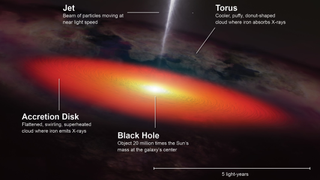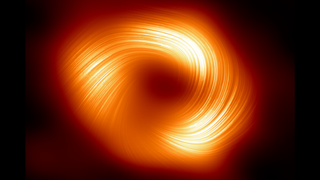Astronomers have spotted flares and echoes coming from the supermassive black hole at the heart of the Milky Way, Sagittarius A* (Sgr A*). These “cosmic fireworks” and X-ray echoes could help scientists better understand the dark and silent cosmic titan around which our galaxy orbits.
The team of Michigan State University researchers made the groundbreaking discovery by combing through decades of data from NASA’s NuSTAR (Nuclear Spectroscopic Telescope Array) telescope. Nine large flares discovered by the team from Sgr A* had been captured by NuSTAR, which has been observing the cosmos with X-rays since July 2012. These signals had previously been missed by astronomers.
Related: New view of the supermassive black hole at the heart of the Milky Way hints at an exciting hidden feature (image)
“We have a front row seat to witness these unique cosmic fireworks at the center of our own galaxy, the Milky Way,” said team leader Sho Zhang, an assistant professor in the Department of Physics and Astronomy at the University of Chicago. Michigan State University, in a press release. “Light flares and fireworks illuminate the darkness and help us observe things we normally wouldn’t be able to.
“That’s why astronomers need to know when and where these flares occur, so they can study the black hole’s environment using this light.”
Light up Sagittarius A* like the 4th of July
Supermassive black holes like Sgr A* are thought to exist at the heart of all large galaxies. Like all black holes, supermassive black holes with masses equivalent to millions or even billions of suns are surrounded by an outer boundary called the event horizon. This is when the black hole’s gravitational influence becomes so intense that even light is not fast enough to match its escape velocity.
This means that the event horizon acts as a unidirectional light-trapping surface beyond which it is impossible to see. So black holes are effectively invisible, detectable only by the effect they have on the matter around them – which, in the case of supermassive black holes, can be catastrophic.
Some of these cosmic titans are surrounded by vast quantities of general matter on which they feed; others chew up stars that venture too close to the event horizon. These stars are shredded by the immense gravitational influence of the black hole before becoming dinner.
In both cases, however, the matter around the black hole forms a flattened cloud, or “accretion disk,” with the black hole at its center. This disk shines brightly across the electromagnetic spectrum due to the turbulence and friction created by the black hole’s intense tidal forces.

However, not all of the material in an accretion disk is funneled into the central supermassive black hole. Some charged particles are channeled toward the poles of the black hole, where they are projected as jets at near the speed of light, also accompanied by bright electromagnetic radiation.
As a result, these voracious supermassive black holes are found in regions called active galactic nuclei (AGN), powering quasars so bright they can outshine the combined light of all the stars in the galaxies around them.
Additionally, not all supermassive black holes are found in AGNs and serve as central engines of quasars. Some are not surrounded by a wealth of gas, dust or unfortunate stars that are too close. This also means they don’t emit powerful bursts of light or luminous accretion disks, making them much harder to detect.
Sgr A*, with a mass equivalent to about 4.5 million suns, happens to be one of these silent, non-voracious black holes. In fact, the cosmic titan at the heart of the Milky Way consumes so little matter that it is equivalent to a human eating a single grain of rice every million years or so.
However, when Sgr A* receives a small snack, it is accompanied by a slight X-ray flare. That’s exactly what the team looked for in 10 years of data collected by NuSTAR from 2015 to 2024.

Grace Sanger-Johnson of Michigan State University focused on the spectacular bursts of high-energy light for the analysis, which provide a unique opportunity to study the immediate environment around the black hole. As a result, she found nine examples of these extreme eruptions.
“We hope that by building this database of Sgr A* flares, we and other astronomers will be able to analyze the properties of these X-ray flares and infer the physical conditions inside the extreme environment of the supermassive black hole,” Sanger-Johnson said. said.
Meanwhile, his colleague Jack Uteg, also from Michigan State University, was looking for something weaker and more subtle around Sgr A*.
A black hole resonates around Sgr A*
Uteg examined the limited activity of Sgr A* using a technique similar to listening for echoes. Examining nearly 20 years of data, he zeroed in on a giant molecular cloud near Sgr A*, known as “the bridge.”
Because clouds of gas and dust like this that drift between stars don’t generate X-rays like the stars themselves do, when astronomers detected these high-energy light emissions from the bridge , they knew they had to come from another source and then be reflected. out of this molecular cloud.
“The brightness we see is most likely the delayed reflection of past X-ray bursts from Sgr A*,” Uteg explained. “We first observed an increase in brightness around 2008. Then, over the next 12 years, the bridge’s X-ray signals continued to increase until reaching their peak brightness in 2020.”
The light that resonates from the bridge took hundreds of years to get there from Sgr A*, and then another 26,000 years to reach Earth. This means that by analyzing this X-ray echo, Uteg was able to begin to reconstruct the recent cosmic history of our supermassive black hole.
“One of the main reasons we want this cloud to get brighter is because it allows us to limit how bright Sgr A* exploded in the past,” Uteg said. This revealed that about 200 years ago, Sgr A* was about 100,000 times brighter in X-rays than it is today.
“This is the first time we have constructed a 24-year variability for a molecular cloud surrounding our supermassive black hole that reached its maximum X-ray luminosity,” Zhang said. “This allows us to tell the past activity of Sgr A* around 200 years ago.
“Our research team at Michigan State University will continue this ‘astroarchaeology game’ to further unravel the mysteries of the center of the Milky Way.”
One of the puzzles the team will seek to answer is what the exact mechanism is that triggers Sgr A*’s X-ray flares, given its sparse diet. The researchers are confident that these results will lead to further research by other teams, speculating that these results could revolutionize our understanding of supermassive black holes and their environments.
The team presented their findings at the 244th meeting of the American Astronomical Society on Tuesday, June 11.